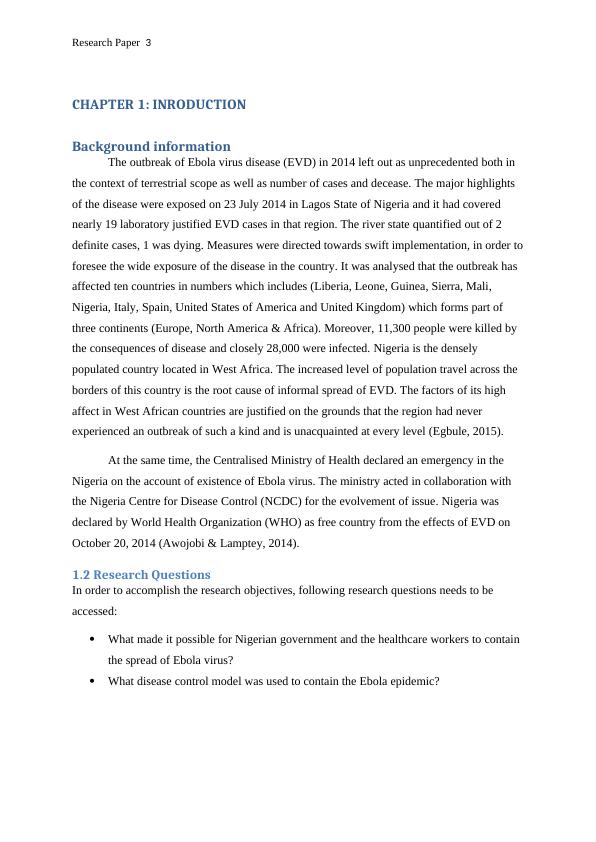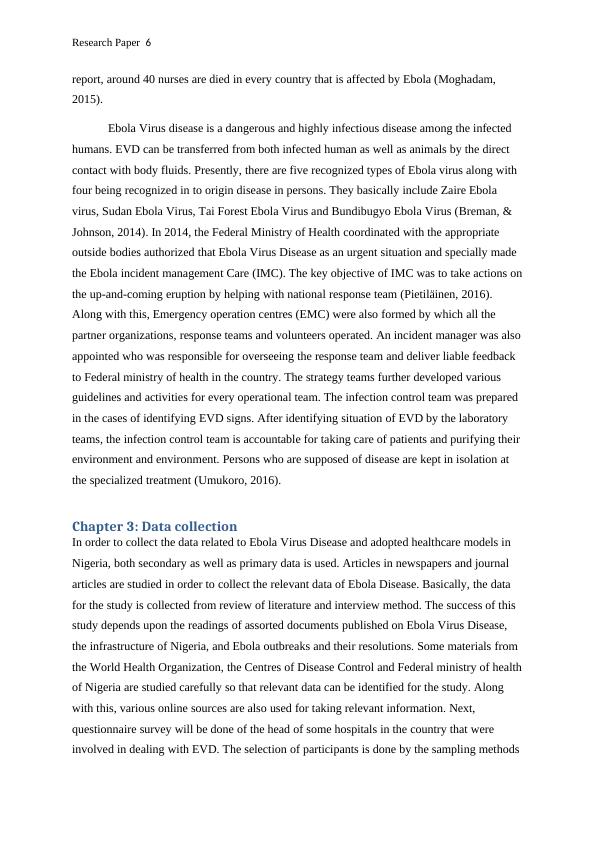(PDF) Ebola Virus Disease: A Literature Review
Added on 2021-04-21
23 Pages5203 Words44 Views
Running Head: Research Paper 1Outbreak of Ebola virus in Nigeria

Research Paper 2ContentsCHAPTER 1: INRODUCTION.................................................................................................3Background information............................................................................................................31.2 Research Questions..........................................................................................................31.3. Research Aim and Objectives.........................................................................................3Chapter 2: literature review........................................................................................................4Chapter 3: Data collection..........................................................................................................6Chapter 4: Methodology............................................................................................................7Chapter 5: Discussion................................................................................................................75.1 Data analysis.....................................................................................................................8Chapter 6: Conclusion..............................................................................................................17References................................................................................................................................18Appendix..................................................................................................................................22Questionnaire........................................................................................................................22

Research Paper 3CHAPTER 1: INRODUCTIONBackground informationThe outbreak of Ebola virus disease (EVD) in 2014 left out as unprecedented both in the context of terrestrial scope as well as number of cases and decease. The major highlights of the disease were exposed on 23 July 2014 in Lagos State of Nigeria and it had covered nearly 19 laboratory justified EVD cases in that region. The river state quantified out of 2 definite cases, 1 was dying. Measures were directed towards swift implementation, in order toforesee the wide exposure of the disease in the country. It was analysed that the outbreak has affected ten countries in numbers which includes (Liberia, Leone, Guinea, Sierra, Mali, Nigeria, Italy, Spain, United States of America and United Kingdom) which forms part of three continents (Europe, North America & Africa). Moreover, 11,300 people were killed by the consequences of disease and closely 28,000 were infected. Nigeria is the densely populated country located in West Africa. The increased level of population travel across the borders of this country is the root cause of informal spread of EVD. The factors of its high affect in West African countries are justified on the grounds that the region had never experienced an outbreak of such a kind and is unacquainted at every level (Egbule, 2015).At the same time, the Centralised Ministry of Health declared an emergency in the Nigeria on the account of existence of Ebola virus. The ministry acted in collaboration with the Nigeria Centre for Disease Control (NCDC) for the evolvement of issue. Nigeria was declared by World Health Organization (WHO) as free country from the effects of EVD on October 20, 2014 (Awojobi & Lamptey, 2014).1.2 Research QuestionsIn order to accomplish the research objectives, following research questions needs to be accessed:What made it possible for Nigerian government and the healthcare workers to contain the spread of Ebola virus?What disease control model was used to contain the Ebola epidemic?

Research Paper 41.3. Research Aim and ObjectivesThe aim of this research study is to forecast how Nigeria effectively coordinated and contained the outbreak of Ebola virus. While achieving the aforesaid aim, the following objectives will be assessed.To identify the health model used by Nigerian healthcare workers. To evaluate the healthcare model used to contain the Ebola outbreak.To evaluate the social impact of the epidemic on the communities and the society generally.Chapter 2: literature reviewThis chapter includes relevant literature review related to the research question. Thereis no much literature that is documented on Ebola. In the literature review, researchers studied the journals and reports that had been done on Ebola in Nigeria. Definition of Ebola- Ebola Virus Disease is the viral infectivity that is the reason of a seriousdisease which can be dangerous if unprocessed. According World Health Organization (WHO), the outbreak of Guinea was the first documented case which was the largest Ebola outbreak ever recorded (Bausa, 2014). There are some high risk factors with this disease i.e. Contact with dead bodies, human body’s fluids and activities with infected people. The key way to protect self is to maintain the highest standards of cleanliness and personal hygiene. Ebola was introduced in the human population by the direct contact with the organs, blood, secretions and other bodily fluids of infected animals like forest antelopes, monkeys and fruit bats (Belpois-Duchamp, Tiv, Astruc & Aho Glélé, 2014). Treatment- The first step in the treatment of Ebola is source isolation to prevent spread of infection. Following measures are taken while managing patients affected by Ebola Virus Disease. Alerting others where they could be treated,Personal protective equipments like wearing the pairs of gloves while handling or preventing from the disease,Avoid using reused or recapped needles,Hand hygiene is mandatory as virus can be easily transferred by the contact. By the hand washing, self and others can be protected effectively,

Research Paper 5Close monitoring of blood pressure is essential Maintaining hydration level to control the disease The Ebola virus disease had spread to major cities with the channel of international airtravel. It forms prominent part of the unparalleled epidemic which started off in Guinea within the era of December 2013. In current time, the virulent infection is the concern in all over the world but there are various health care measures are taken in the Ebola-infected areas. Ebola Virus Disease (EVD) is basically haemorrhagic fever which is challenging societies, health workers and health systems of various countries across the world (Diakite, 2014). It is very important that health workers and nurses are trying to contain the disease effectively and providing safe and secure care to those who are affected with this disease. By the time, this issue has been become a serious challenge for the health sector (Miller, 2016). According to World Health Organization (WHO), Ebola is the serious issue that needs to be addressed on the urgent basis. Due to Ebola, current death rate in West Africa is 50% and now it is affecting other countries i.e. Sierra Leone, Guinea and Nigeria. These are those countries that have unable and inadequate health systems along with widespread poverty. In order to contain the infection, the training is provided to the health workers (Duru, 2016). WHO and International Red Cross are the part of the international workforce making efforts data collection, treatment, co-ordination and containment. It is observed that infected people are still not getting effective treatment in many countries as there are not enough beds,and aid agencies. Along with this, there is the shortage of doctors, health workers and nurses (Lupamo & Tavakolipanah, 2016). Despite of risks of infection to themselves, nurses, doctorsand other health workers with the government and non-government workers are on the ground of Nigeria in order deal with EVD. Overcoming from misinformation and myths is the big part of community efforts to deal with the disease and to get early treatment of the affected people (Gsteiger, Althaus & Shuaib, 2015). For this, nurses need to have special training to stop the disease. According to International Council of Nurses, in 14 districts in the country, around 568 nurses has received training related to Ebola care, information, measures and treatment to prevent its spread including safe burial of death. Along with this, ICN also pointed out the government and organizations need to focus on addressing the impact of Ebola on people by ensuring that they are receiving adequate and appropriate training, protective equipments and support to deal with the disease. It is not easy for the health workers to deal and manage the disease. For instance, it is observed that The Nigerian nurse who cared for the victim has died. Along with this, according to Australian news team

Research Paper 6report, around 40 nurses are died in every country that is affected by Ebola (Moghadam, 2015). Ebola Virus disease is a dangerous and highly infectious disease among the infected humans. EVD can be transferred from both infected human as well as animals by the direct contact with body fluids. Presently, there are five recognized types of Ebola virus along with four being recognized in to origin disease in persons. They basically include Zaire Ebola virus, Sudan Ebola Virus, Tai Forest Ebola Virus and Bundibugyo Ebola Virus (Breman, & Johnson, 2014). In 2014, the Federal Ministry of Health coordinated with the appropriate outside bodies authorized that Ebola Virus Disease as an urgent situation and specially made the Ebola incident management Care (IMC). The key objective of IMC was to take actions onthe up-and-coming eruption by helping with national response team (Pietiläinen, 2016). Along with this, Emergency operation centres (EMC) were also formed by which all the partner organizations, response teams and volunteers operated. An incident manager was alsoappointed who was responsible for overseeing the response team and deliver liable feedback to Federal ministry of health in the country. The strategy teams further developed various guidelines and activities for every operational team. The infection control team was prepared in the cases of identifying EVD signs. After identifying situation of EVD by the laboratory teams, the infection control team is accountable for taking care of patients and purifying their environment and environment. Persons who are supposed of disease are kept in isolation at the specialized treatment (Umukoro, 2016). Chapter 3: Data collectionIn order to collect the data related to Ebola Virus Disease and adopted healthcare models in Nigeria, both secondary as well as primary data is used. Articles in newspapers and journal articles are studied in order to collect the relevant data of Ebola Disease. Basically, the data for the study is collected from review of literature and interview method. The success of this study depends upon the readings of assorted documents published on Ebola Virus Disease, the infrastructure of Nigeria, and Ebola outbreaks and their resolutions. Some materials from the World Health Organization, the Centres of Disease Control and Federal ministry of healthof Nigeria are studied carefully so that relevant data can be identified for the study. Along with this, various online sources are also used for taking relevant information. Next, questionnaire survey will be done of the head of some hospitals in the country that were involved in dealing with EVD. The selection of participants is done by the sampling methods

End of preview
Want to access all the pages? Upload your documents or become a member.
Related Documents
A Review of Ebora Viral Diseaselg...
|17
|4908
|36
Essay on Ebola Outbreak Preventionlg...
|14
|4066
|199
Article on Ebola Managementlg...
|9
|3179
|34
Summary on Ebola Virus Infection | Studylg...
|6
|1378
|23
Ebola Crisis and Intervention Strategylg...
|11
|2025
|147
Public Health Response to Ebola Outbreaklg...
|4
|893
|487
